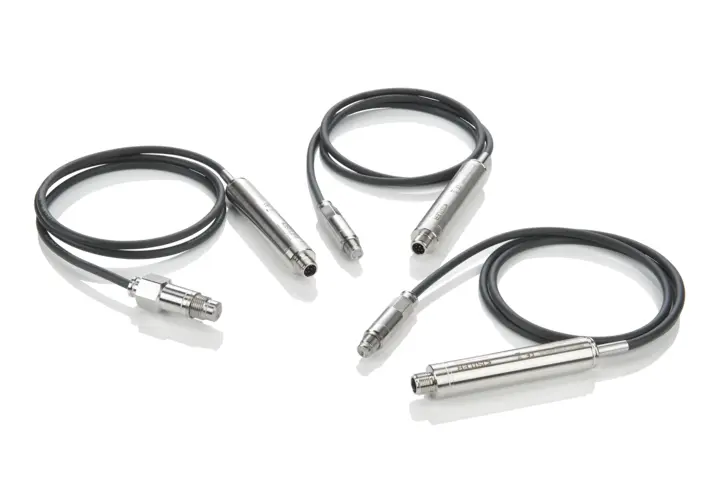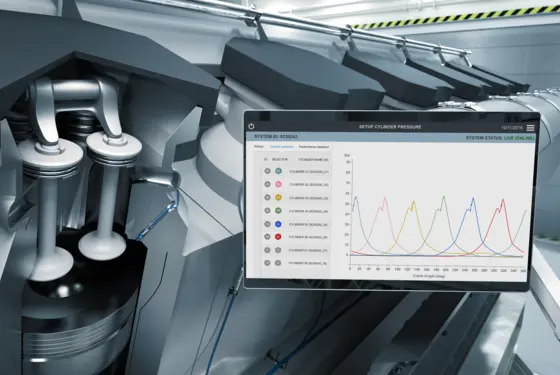Around the globe, more than 10,000 ships are equipped with cylinder pressure sensors from Kistler. Today, it is common for these slow-running large motors to be operated in what is referred to as closed-loop combustion control (CLCC). Cylinder pressure sensors from Kistler allow for this kind of control and must reliably provide precise measurement data under difficult conditions – as they are in continuous operation, they are therefore exposed to extreme vibrations and temperatures. Continuous combustion analysis is carried out on the basis of the measurement results obtained from these sensors. On the basis of this analysis, the automatic engine control intervenes in real time, adjusting the engine to balance the combustion processes in all cylinders. This decreases the mechanical strain on the engine, improves fuel efficiency and reduces emissions. A marine engine controlled in this way emits an average of 2,000 (metric) tonnes less CO₂ in one year. Multiplied by the total number of ships equipped with Kistler cylinder pressure sensors, the annual CO₂ savings amount to more than 20 million (metric) tonnes of emissions.
New cylinder pressure sensors for future requirements
At the CIMAC Congress, Kistler is presenting its new piezoelectric cylinder pressure sensors for slow-running large engines, which have been designed not only for current requirements but also for those of the future. With the new sensor types (6636A2 and 7636A2), Kistler is setting benchmarks in this sector. Compared to their predecessors, Kistler was able to dynamically expand the overload range to 450 bar coupled with resistance to temperatures of up to 350°C. The use of Kistler’s unique PiezoStar crystal technology plays a key role here. This technology uses crystals that are grown by Kistler in Winterthur and which are up to five times more sensitive than the quartz crystals normally used in these kinds of sensors. PiezoStar crystals offer excellent measurement stability at nearly any temperature. Continuous operation of the sensors for combustion monitoring in large engines requires an extremely robust design. Conventional plug connections for signal transmission have been replaced by welded connections, making the sensors far less sensitive to vibrations and guaranteeing significantly more stable transmission of measured values. Moreover, the unique anti-strain design of the new cylinder pressure sensors offers superior stress resistance. The advantages of this new generation of sensors are evident not only in marine engines operated with heavy fuel oil and natural gas; they are also suitable for engines using hybrid fuels or “future fuels” like methanol, ammonia and hydrogen.
Kistler paves the way for sustainable energy solutions with cutting-edge research
Miika Jussila, Head of the Business Unit Engine Marine & Stationary at Kistler, explains: “At the moment, it’s not clear which fuel will prevail in the future. In the coming years, we will likely have an ecosystem with different fuels.” Regardless of the fuels used, cylinder pressure sensors from Kistler will play an even more important role than they already do today. Currently, dual-fuel engines are already in use. They can be switched from conventional liquid fuels to liquid natural gas as needed. To ensure that these engines can provide optimal power, the internal combustion processes must be monitored and regulated. “No matter which fuels are combined, sensors are indispensable,” emphasizes Miika Jussila. For Kistler, it is extremely important to be directly involved in these developments. For this reason, the company continuously invests in research and development so that it can contribute to achieving climate goals through innovative solutions. At the CIMAC World Congress, the latest findings from research in the field of next-generation fuel mixtures – specifically, a combination of ammonia and hydrogen – will be presented. The research will then be published in the form of a white paper, demonstrating how cutting-edge research is paving the way for sustainable energy solutions.
Technical Tour will visit Kistler location in Winterthur
One of the particular highlights of this year’s CIMAC Congress will be the Technical Tours. These tours will take participants on a journey through several technology companies. On May 23, the tour will spotlight four companies in Winterthur, including a Kistler location. Kistler will offer visitors a fascinating program along with exclusive insights into its Research and Development and Production divisions – a unique opportunity to speak with experts on location.
Kistler with information booth at the CIMAC World Congress
This year, Kistler’s booth (booth No. 16) will be located in the entrance area of the Zurich Convention Center. Specialists will be on hand to provide visitors with qualified information. Kistler’s CIMAC Congress Team looks forward to lively discussions with the attendees.





![CIMAC World Congress 2025: Kistler Presents Cylinder Pressure Sensors for Reducing CO₂ Emissions [object Object]](https://kistler.cdn.celum.cloud/SAPCommerce_Document_Preview/962-026e.webp)